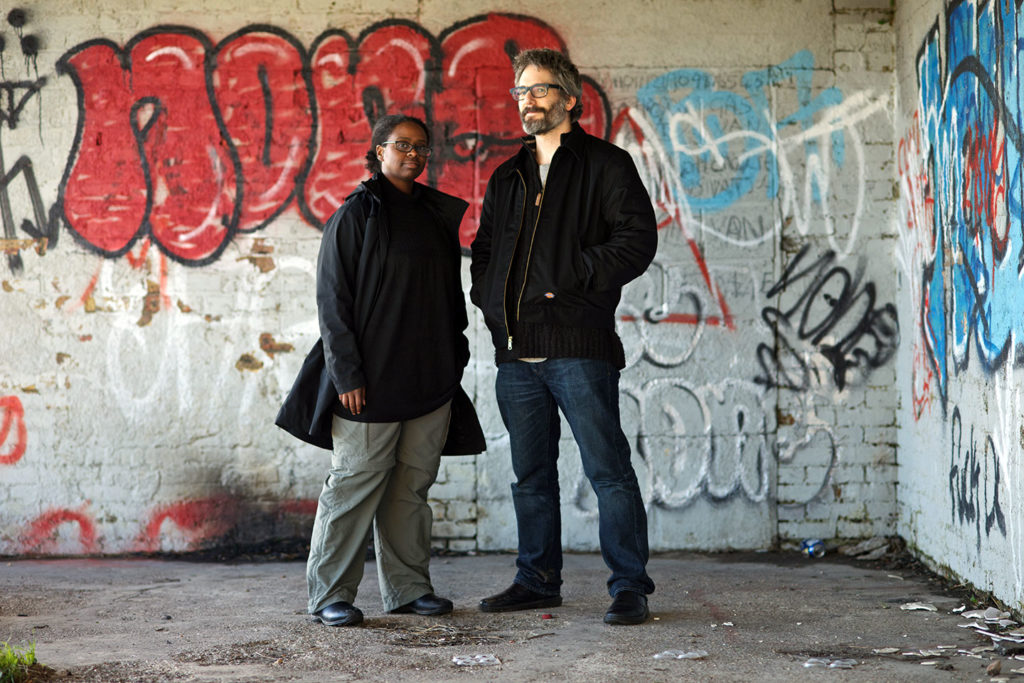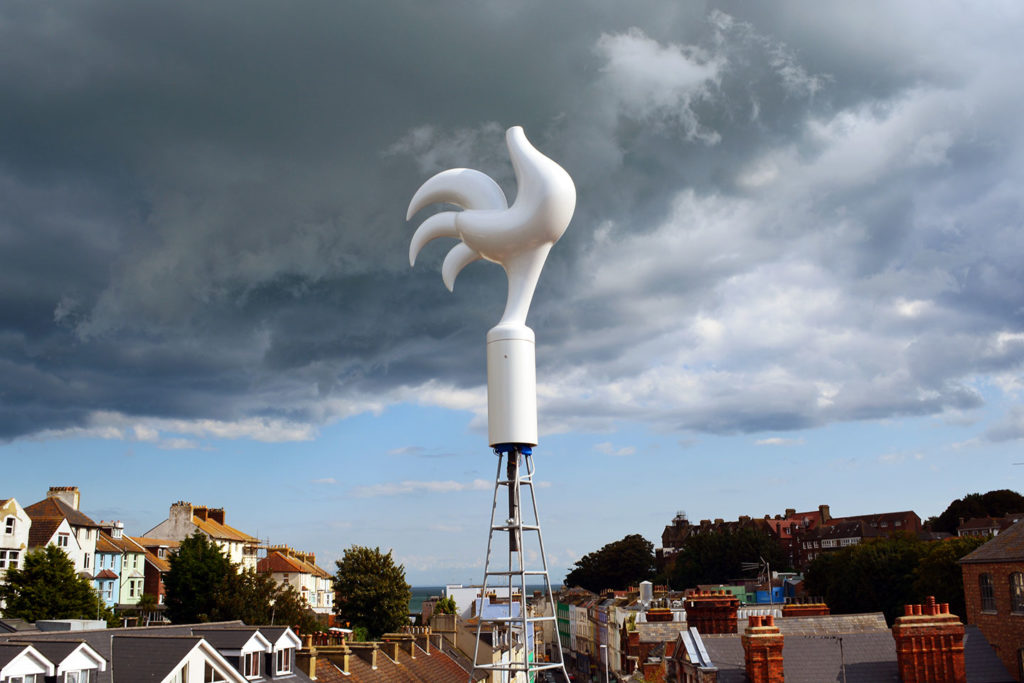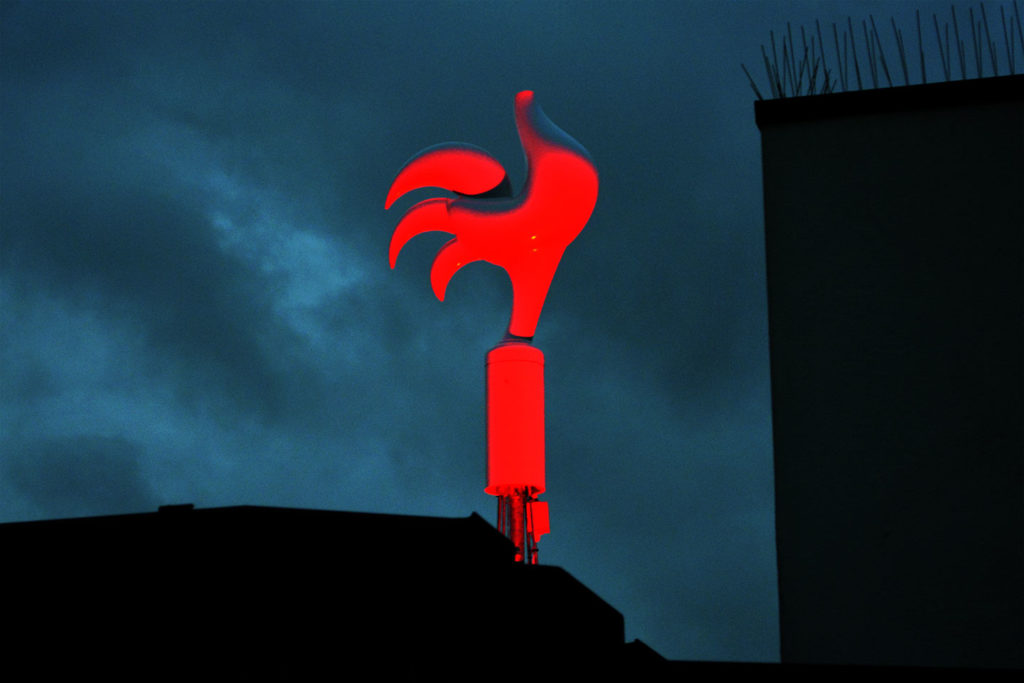Whithervanes track fear in the media
History will ultimately decide how future generations look back on the 2016 election cycle and general social climate of this time, but there is little question that one of the biggest antagonists in the story of 2016 will be the the 24-7 news cycle and the stream of hyperbolic and bombastic stories around race, immigration, the state of the economy and terror.
This was the impetus for Whithervanes, a project being development by rootoftwo for the Locust Projects in Miami.
Founded in Wynwood in 1998, Locust Projects is a nonprofit exhibiting space dedicated to providing contemporary visual artists the freedom to experiment with new ideas and create site-specific installations as an extension of their representative work.
The Whithervane is a sculpture of a headless chicken with its movements and colors controlled by the climate of fear in the media. The number of times the chicken spins and the color it turns is based on the fear threat level – mirroring the color coding of the Terror Alert Chart – and it also faces away from wherever in the world the threat has originated.
“Whithervanes is the most ambitious temporary public art projects we’ve ever undertaken, and [with more than two years of planning] it’s one of the longest lead-time projects we’ve ever worked on,” says Executive Director Chana Budgazad Sheldon. “But what [roofoftwo is] doing is so important, and how it would involve the community in a really meaningful way was really attractive to us.”
rootoftwo is a creative partnership between Cézanne Charles and John Marshall formed in 1998. It is a “hybrid design studio” that utilizes experimental tech and new media in interactive design work that includes everything from small-scale devices to furniture to larger-scale works in public realms. They recently relocated to Ann Arbor, Michigan, where they began finding inspiration in the area’s agrarian past and how the radical changes ushered on by the Industrial Age and Henry Ford’s automobile were still closely tied to that shifting agrarian identity.

At the time they had just spent two years working on an exhibit for the Museum of Modern Art in Kyoto that examined the theme of where the Industrial Age met Modernism. Specifically, the exhibit was about reconsidering the Kyoto Protocol 10 years after it went into effect.
“We were spending a lot of time at the Henry Ford Museum and were really holding onto this iconic idea of industrial heritage,” says Charles. “We wanted to look again at our new surroundings in Michigan, the pre-condition of the Industrial Age in Michigan. Henry Ford had this whole story about being inspired by the agrarian worker. There is this running narrative in Detroit that urban farms are the future, yet its future used to be its past.”
With this sort of pre-Industrial Age agrarianism already on their minds, they also found themselves in their new American home assaulted by the uniquely American phenomenon that is Fox News.
“Fox News is a distortion of the media,” Marshall says. “You pay attention to the media you want to hear that reinforces your worldview. [Whithervanes] came from anger, from shouting at the television, in that echo chamber of listening to your own point of view sent back to you and everyone all running around like headless chickens. At that point it came together.”
A weathervane is certainly an object most people are familiar with, though arguably most people today have never once needed to use it for its intended purpose. It is an informatics device that was once a very important tool that helped agrarian workers keep track of the weather and their crops.
“It was actually an important and functional icon of its era; now it’s just used for decoration,” says Charles. “We wondered what would it be to reclaim it for the 20th century?”
“The humor is a way for people of different points of view to enter into conversations with each other,” Marshall says. “We try to put a lot of humor in the work. Without appreciating beauty, what’s the point? We can at least just appreciate them as spinning chickens that change colors.”
Charles says, “We’re trying to find our own agency over these systems that are really vast and really complex that we have no power over. We personally could rediscover that agency but we are trying to afford that opportunity for the audience as well. The other part is, given that the news is tied to a constant full-throttle anxiety-producing message, we really wanted to understand how that related to what people actually experience in their environment.”

The first Whithervane project was in 2014 at the Folkestone Triennial. Five sites were selected that included a working class pub, an adult education center, a Michelin-starred restaurant, a theatre, and a Napoleonic watchtower. There will be three sites selected for the Miami installation, including the rooftop of Locust Projects, which will serve as the project “command center.”
A big component of the Whithervanes project is a series of community engagement workshops, at which community members are able to enter keywords into a database of fear that controls news stories. The starting set of keywords came from the Department of Homeland Security’s “Analyst’s Desktop Binder,” which is used to monitor keyword usage online for threat of possible terrorist activity.
From there more keywords are added based on feedback from the community workshops, giving community members a sense of ownership in the project (and in the media) and allowing them a space to talk about their fears. The workshops are also educational: participants learn basic computing and programming skills for controlling light and motion.
Once locations for installation have been established, local news sites in their immediate surroundings also inform the Whithervanes, so the concerns of one community – say, perhaps, immigration reform and threats of deportation – will be more apparent in the Whithervane’s reactions than in another community where the Zika virus might be more of a mass panic trigger.
In Miami there is likely going to be a lot of fear and feedback on immigration, climate change, the Zika virus, “Brazillionaires” and the impact Brazil’s economic downturn is having on the local economy, and the city’s relationship to Cuba, though different neighborhoods will have differing levels of reaction to these issues.
In Folkestone, migration was a big fear, as was Ebola at the time. This was pre-Brexit and there was already a strong sentiment of rejecting Europe, so the visual symbolism of the headless chicken – vaguely recalling the image of the Gallic rooster, the symbol of the French national football team – had several layers of meaning. Somewhat cheekily, Charles and Marshall also made the towers on which the Whithervanes were displayed to be in the same proportions as the Eiffel Tower.
“We play at a subtle level,” says Charles. “You kind of feel like it’s familiar in some way, but we play it in a way that it does not immediately trigger a reaction, but is culturally familiar and relevant. This is what design sensibility does for the project: looking at what is the nuanced way of presenting the project.”
Additionally, an unintentional layer of symbolism is added to the Whithervanes by virtue of Miami’s cultural heritage: the practice of the Afro-Caribbean religion of Santeria, which grew out of the Cuban slave trade and includes the practice of sacrificing chickens through decapitation.
One challenge they’re having with planning the Miami is certainly not one they had to deal with in Folkestone: the Whithervanes have to be able to withstand winds of 175mph, since the target installation date will have them up for the duration of hurricane season from September 2017 to January 2018.

Add to that another layer of metaphor: chickens blowing in the wind.
The Whithervane allows the public to manipulate the background of fear perpetuated in the media by voting for #skyfall (as in, Chicken Little, the sky is falling!”) or #keepcalmandcarryon on the project website to actively decide, rather than passively be manipulated by, news media. Entering the former adds more fear into the system to which the chickens respond accordingly; the latter takes some of the fear out. Once their votes are cast, viewers can then see a real-time map of the current status of each of the chickens, each of which are calibrated to their local news and feedback from their respective workshops.
Beyond these two commissioned installations in Folkestone and Miami, Charles and Marshall are interested in continuing the workshops and the skill-building and communication that came out of them in a way that is “open source,” becoming a platform for building community available freely in the public realm.
Through support of the Knight Foundation, rootoftwo is working on a small-scale toolkit looking at justice and equality through the lens of the media. This toolkit will allow people to build a database around what they’re interested in, and therefore allow them to similarly build community around these issues along the same vein as the Whithervanes. They plan to have this toolkit ready with the Locust Projects installation next fall. Community workshops for the Miami installation will begin early next spring: less than a year and yet a lifetime from now, in terms of the 24-hour news cycle.

Questions answered by Cézanne Charles.
(1) How do you like to collaborate?
Often. A lot. In our individual practices there was always an element of really being in dialogue with the work or the public or some sort of co-creative act. We have to dispel the myth that somehow collaboration is about everyone being in the same thought space; there is a flow of building things together. We might have similar views and are angry at the same things in the world, but [collaboration is really having] a place where you can duke it out. It is as much about being able to disagree and be disagreeable as much as it is to say, “Oh, this is awesome.”
(2) How do you a start a project?
We normally start a project with something that pisses us off. If it’s a real pinch point that keeps coming up and it’s something that’s needling us, then we go out and do a lot of research. There’s always a research component. Each project starts with a heavy research and analysis approach. Even if it’s something we’re disgruntled about we try to check our own biases: how do we move on from what we’re disgruntled with to something more universal?
(3) How do you talk about your value?
We tend to find value in our own projects and our exchanges with people in our work in our respective day jobs as really coming from an exchange of ideas and an exchange of learning. Our first-tier value proposition is: “What did we learn? Did we learn something?”
(4) How do you define success?
When feel all of the narrative of the project has revealed itself there is normally a high-five moment where we feel like, “Okay, all these different things and different ideas have come together in this way; this is a thing it belongs in the world.” I think the biggest success for us is when the project is received – when it’s no longer ours, when people get to myth-make and story-tell about the project. We really like that.
(5) How do you fund your work?
We get research grants through [the University of Michigan]. We are also recipients of Knight Arts Challenge grants. In the United Kingdom we got arts council grants and support. Some of our work is commissioned and we have some sales. As much as possible we try to use our day jobs to fund our lives and not our work. We really try not to have it pay for the production or research of the artwork. We’re not at the point of earning salaries through our projects.
